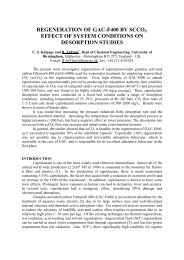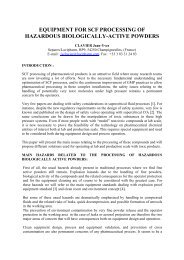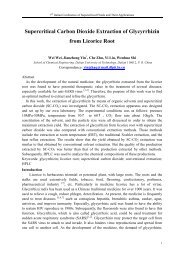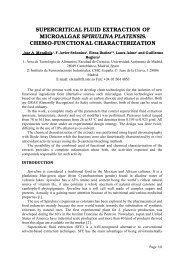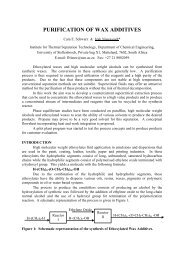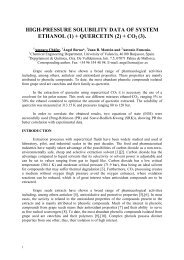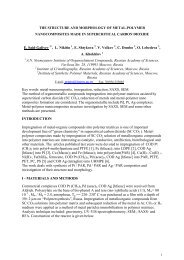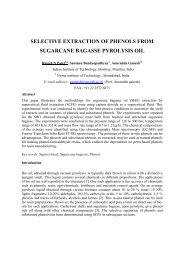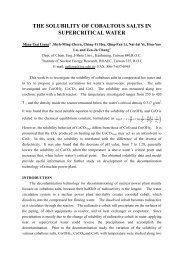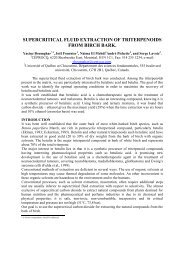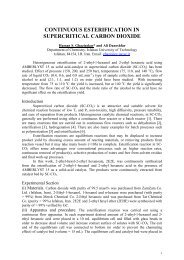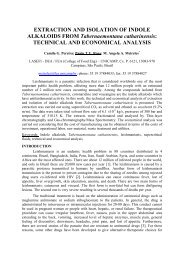Novel Organic Synthesis in Supercritical Carbon Dioxide - ISASF
Novel Organic Synthesis in Supercritical Carbon Dioxide - ISASF
Novel Organic Synthesis in Supercritical Carbon Dioxide - ISASF
You also want an ePaper? Increase the reach of your titles
YUMPU automatically turns print PDFs into web optimized ePapers that Google loves.
BOX CATALYSED ASYMMETRIC CYCLOPROPANATION REACTIONS<br />
The cyclopropyl group is found as a basic structural element <strong>in</strong> a wide range of naturally<br />
occurr<strong>in</strong>g plants and micro-organisms [2,6]. Asymmetric cyclopropanation reactions have<br />
been extensively studied, and are usually carried out <strong>in</strong> conventional solvents such as CHCl 3<br />
and CH 2 Cl 2 . Studies have also been carried out <strong>in</strong> scCHF 3 demonstrat<strong>in</strong>g <strong>in</strong>terest<strong>in</strong>g solvent<br />
effects [7]. In conventional solvents, the gem-dimethyl derivative typically gave the best<br />
enantioselectivity, hence is the most widely used chiral BOX ligand [8].<br />
O O<br />
N N<br />
Cu<br />
t-Bu t-Bu<br />
R 2 TfO OTf<br />
+<br />
R R R 1 R 2<br />
1 1 R<br />
+<br />
2<br />
N2 CHCl 3 or CH 2 Cl 2<br />
+<br />
R 2<br />
R 2<br />
R 1 or R 2 = aliphatic or aromatic<br />
Scheme 3<br />
BOX CATALYSED CYCLOPROPANATION REACTIONS IN scCO 2 COMPARED<br />
WITH CONVENTIONAL SOLVENTS<br />
Cyclopropanation reactions of styrene and ethyl diazoacetate were performed <strong>in</strong> scCO 2 us<strong>in</strong>g<br />
1 mol% BOX catalyst at different pressures to identify conditions for optimum selectivity.<br />
The same reactions were also carried out <strong>in</strong> chloroform and toluene as conventional solvents<br />
comparison. Results are presented for the four ligands shown <strong>in</strong> Scheme 4.<br />
Ph<br />
+<br />
N 2<br />
CO 2 Et<br />
R 2 R 2<br />
O O<br />
N N<br />
Cu<br />
R 1 R 1<br />
TfO OTf<br />
scCO 2<br />
Ph<br />
CO 2 Et<br />
+<br />
Ph<br />
CO 2 Et<br />
+<br />
EtO 2 C<br />
CO 2 Et<br />
R 1 = i Pr, t Bu or Bn<br />
n-Bu<br />
O<br />
n-Bu<br />
O<br />
EtO 2 CH 2 C<br />
O<br />
CH 2 CO 2 Et<br />
O<br />
N<br />
N<br />
N<br />
N<br />
R 2 = n Bu, CH 2 CO 2 Et, CH 2 CONEt 2<br />
N N<br />
1 2<br />
Et 2 NOCH 2 C<br />
O<br />
CH 2 CONEt 2<br />
O<br />
O<br />
O<br />
N<br />
N<br />
3 4<br />
Scheme 4



